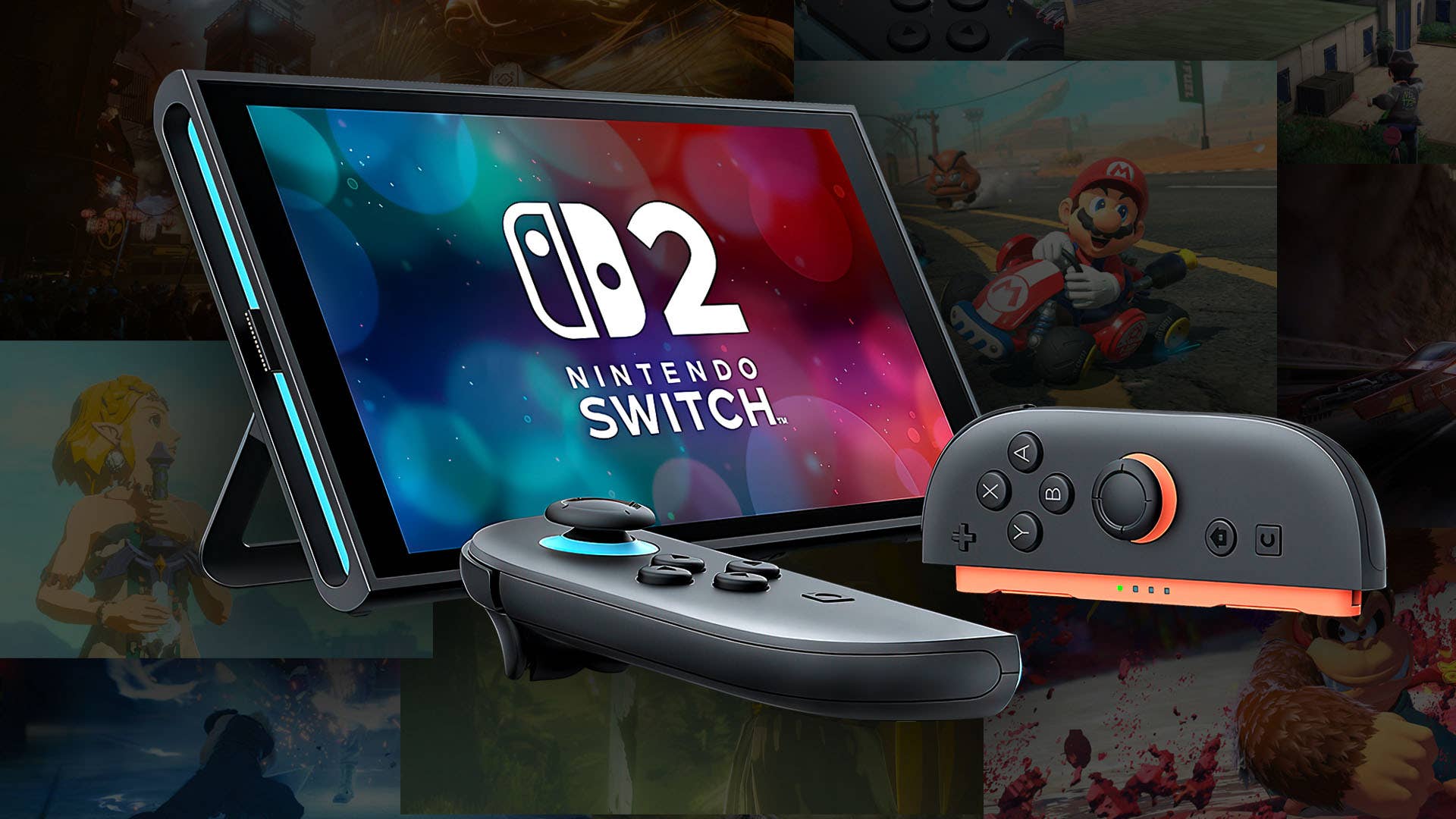
The Nintendo Switch 2 represents a pivotal moment for Nintendo's console strategy, promising generational improvements while maintaining the core philosophy of hybrid gaming for both TV and handheld play. Going into this review, we had many questions: to what extent is a generational leap delivered? What are our general impressions on system performance? What are the characteristics of the hardware form factor and accompanying peripherals? The answers to these questions are generally positive but when it comes to LCD screen quality along with its signature VRR and HDR features - well, unfortunately, the drawbacks of Nintendo's display choices far outweigh the benefits.
In terms of its core hardware specifications, Switch 2 uses a custom-built Nvidia processor based on what has been identified as a potential hybrid of Samsung's 8nm and 10nm fabrication nodes - a step behind the 7nm and 6nm chips found in Steam Deck and its updated OLED model. It features eight ARM Cortex A78C CPU cores (six available to developers) that should represent a generational leap over Switch 1, though comparisons against current-gen consoles may prove less impressive based on Cyberpunk 2077 performance. Clock speeds run at 998MHz docked and - bizarrely - 1100MHz in handheld mode. There's a theoretical 1.7GHz max.
For the GPU, T239 features 1,536 CUDA cores based on Nvidia's Ampere architecture, as found in the RTX 30-series line of graphics cards, supporting machine learning and ray tracing. The GPU clocks at 561MHz in handheld mode, rising to 1007MHz in performance mode (typically for docked play). Constrained for thermal and battery life reasons, theoretically the GPU can max at 1.4GHz. 12GB of LPDDR5X memory runs at 6400MT/s while docked for 102GB/s of bandwidth in performance mode, which is downclocked to 4200MT/s in handheld play. Of the 12GB available, Nintendo has a system reservation of 3GB, leaving 9GB for use by developers.
| Switch 2: Nvidia T239 | Switch 1: Nvidia Tegra X1 | |
|---|---|---|
| CPU Architecture | 8x ARM Cortex A78C | 4x ARM Cortex A57 |
| CPU Clocks | 998MHz (docked), 1101MHz (mobile), Max 1.7GHz | 1020 MHz (docked/mobile), Max 1.785GHz |
| CPU System Reservation | 2 cores (6 available to developers) | 1 core (3 available to developers) |
| GPU Architecture | Ampere | Maxwell |
| CUDA Cores | 1536 | 256 |
| GPU Clocks | 1007MHz (docked), 561MHz (mobile), Max 1.4GHz | 768MHz (docked), up to 460MHz (mobile), Max 921MHz |
| Memory/Interface | 128-bit/LPDDR5 | 64-bit/LPDDR4 |
| Memory Bandwidth | 102GB/s (docked), 68GB/s (mobile) | 25.6GB/s (docked), 21.3GB/s (mobile) |
| Memory System Reservation | 3GB (9GB available for games) | 0.8GB (3.2GB available for games) |
Despite scepticism on the suitability of the older Samsung process, the system typically maxes at 22W (measured from the wall) during docked play, dropping to around 10 to 12W in handheld mode - though those figures will include the inefficiency of the power supply. The battery is 19.75Wh, so actual battery life is the arbiter of consumption. Nintendo cites a minimum of two hours of play, suggesting a 10W ceiling on power draw in handheld mode in the most demanding games. Our results verify this - a remarkable achievement for Nintendo, Nvidia and indeed the Samsung process. With games like Mario Kart World and No Man's Sky, we successfully logged 2.5 hours of play, meaning an average power draw of just under 8W.
Switch 2 looks like an efficiency king then, defying expectations. However, there are a couple of asterixes and caveats to attach to that statement. First of all, based on our testing, the hardware never exceeds 22W in consumption when docked - meaning that if you're expecting to charge the battery while maxing out system performance in TV gameplay, you're in for a disappointment. Battery charging in this scenario is glacial in nature. However, if you connect the charger to the machine to continue handheld play, the PSU powers your gameplay session and charges the battery with around 25W of consumption.
In terms of hardware design, we're happy overall with Nintendo's choices. Despite being significantly larger than Switch 1, the thinness of the handheld remains much the same, making it feel significantly less bulky than Steam Deck and other PC handhelds. Similarly, the bigger screen can make for a more immersive experience and colour reproduction is significantly improved over the original model. What's also surprising - and highly appreciated - is the number of games that either run at native 1080p in handheld mode (like Mario Kart World, for example) or use DLSS to upscale to 1080p, delivering pleasing results.
However, the screen itself is problematic in a number of ways. Nintendo promised HDR, but an edge-lit LCD that barely tops out at 420 nits will never deliver anything like a decent high dynamic range experience with the signature HDR contrast and highlights almost completely absent in handheld play. Even more disappointing is motion quality: the Switch 2 LCD has blurring characteristics that are easily worse than the 2017 Switch's display. Side by side with the Switch OLED panel, the key problems with Nintendo's choice for Switch 2 come into sharp focus - it's simply nowhere near as good.
There are clear problems with Switch 2's VRR (variable refresh rate) functionality too. Now, in theory, we believe that there's no reason why it should not work effectively. The Switch 2 Welcome Tour software includes a VRR showcase that demonstrates what we think is a 40-120Hz VRR window, but crucially it also reveals support for LFC - low frame-rate compensation - outside of that window. A fully featured VRR on Switch 2 is possible!
However, this is not borne out in any of the other software we've tested. Cyberpunk 2077 and No Man's Sky both offer handheld display modes that top out at 40 frames per second: prime territory for low frame-rate compensation to step in when performance drops under the target performance level. However, when this does happen on both games, the judder is clearly perceptible. This isn't VRR as we'd typically expect to experience it and in both cases, we recommend opting for the locked 30fps alternative in the menu for a smoother overall experience.
We also tested Hitman: World of Assassination which only has a single frame-rate mode - fully unlocked up to 60fps. In theory, this is a great companion for VRR, but we found that the game would 'ping pong' between VRR fluidity and obvious judder depending on the complexity of the scene. Again, we'd hazard a guess that everything is fine at 40fps and over but things go awry under the 40fps threshold.
Moving onto other areas where we expected key Switch 2 improvements, we had high hopes for a decent WiFi upgrade, bearing in mind weak performance on every single Switch 1 model we've had. In our testing, we placed both Switch OLED and Switch 2 12 feet away from the WiFi router and behind a wall. Based on a 1.5Gbps internet connection, the internet connection test saw Switch 2 achieve a download speed score an order of magnitude better than Switch OLED: 363Mbps vs 32.6Mbps (!).
Moving on to ethernet connection testing, the new hardware also delivers a huge improvement: 720Mbps vs 154Mbps. The icing on the cake is that unlike original Switch 1 docks (OLED excepted), Switch 2 does contain an Ethernet port - no dongles required. As is the case with typically all devices, speedy downloads will be that much speedier by providing a hard-wired connection to your router.
Looking at some actual loading time tests, Persona 4 Golden weighs in as a 9.1GB download, which took seven minutes on Switch 2 up against 32 minutes on Switch 1. Switching to the Ethernet results, the original Switch's results are dramatically improved at 12.5 minutes, but Switch 2 still did much better with a mere 5.5 minute download speed. All told, WiFi throughput is much improved.
WiFi performance is also key when considering the Game Share function Nintendo is now offering. The premise is simple: instead of split-screen, certain games can be shared with other Switch owners with the Switch 2 acting as a LAN-based "cloud server" of sorts, streaming video across your network, but doing so while the main player gets their own full-screen experience. It's an ambitious feature that will, of course, have its own overhead as one Switch is basically rendering two gameplay instances.
Testing in Fast Fusion - a super-fast game that relies on crisp response - highlights the problems. First of all, while the other player does receive a 60fps feed, the quality of the video is poor (a criticism that can also be levelled at system level game capture, actually). Typically the faster the action, the more break-up you'll see in the feed given to the client player - and the quality is akin to a 360p YouTube encode. Occasional hitches and freezes won't help matters here, particularly on a game like Fast Fusion, while input lag is also a concern - response just isn't fast enough.


Choosing Fast Fusion as a stress test obviously pushes the feature too far, but on games with lower levels of motion and less reliance on low input lag, Game Share may have more merit - but there remains the sense that it should have been better. More generally, video encoding on the internal media block should be much better - T239 apparently has the same core media technology as RTX 40-series based on Nvidia leaks. However, the 30 second 1080p30 AVC files saved by the internal capture function are of a very poor quality. Even static scenes seem to have macroblocks that "strobe" in and out of view.
Far more successful is Game Chat - Nintendo's signature new feature for Switch 2. In four-player testing with the Digital Foundry team, we found it to well put together and a great deal of fun with some impressive technology on display. You can think of it as a Discord-like integrated OS-level communication system supporting up to four players. There seems to be an injection of Nvidia RTX broadcast technology here: AI-powered voice isolation is astonishingly effective to the point where we could easily understand John Linneman, despite him using the feature with loud music and an AC unit running at maximum warp in the background. Only when the game itself features voice does Game Chat get a little confused about what to filter.
Also impressive is how Game Chat isolates players from their backgrounds in the camera feed and beams out the imagery to all connected users - and there are interesting options too. Mario Kart World, for instance, allows Game Chat to isolate the player's head only, inserting it on-screen above their vehicle. Should those players move their heads, Game Chat tracks and updates appropriately. Video feeds from connected players appear to run at 10 frames per second with rather low quality, but the overall look is effective. What is slightly bizarre is that that UI elements in Game Chat appear to be native 1080p, even on a 4K output but thankfully the main player feed doesn't look to have been squeezed down into a 1080p container.
There is a cost to Game Chat, however, but you do have to hunt down instances where it happens. Mario Kart World ran beautifully without issue but in like-for-like Cyberpunk 2077 tests, we could see Game Chat occasionally hit system resources, lowering game frame-rate or causing issues in the set-up to some of CDPR's internal streaming tests, resulting in assets taking longer to appear than they should. By way of a "real world test", we had Tom Morgan on our Game Chat session playing Cyberpunk 2077 normally, and he didn't feel as though the system was meaningfully impacted. One final detail: Game Chat only seemed to make an impact in CPU-limited Cyberpunk tests - a primarily GPU-limited test saw no performance reduction at all. Testing subsequent to our video review seemed to suggest that the fewer the amount of players in a Game Chat session, the less of a performance hit there is. Ultimately though, the impact seemed fleeting in Cyberpunk 2077 and basically non-existent in Mario Kart World. Game Chat itself is excellent and a welcome addition to the Switch 2 feature set.
In summary, our thoughts on Switch 2 are generally positive. Screen apart, the hardware is well-built: the revised Joy Cons are an improvement, the larger form factor is not too onerous and the tiny quality of life improvements (such as little 'feet' on the bottom of the unit) are appreciated. This is the original Switch revised and refined into a generally more pleasing and more effective unit, delivering a proper generational upgrade with highly impressive efficiency. It comes to something when, screen apart, the biggest criticism I personally have concerns that limited length USB-C cables provided for the power supply and especially the camera. Thankfully, the USB-C cables are detachable and replaceable - but they should have been longer.
Special mention should go to the Pro Controller: build quality is excellent, it feels great in the hand, while button feedback is pleasing. The d-pad is excellent, while the analogue sticks are exemplary. None of the DF team are particularly fond of paddle buttons, but their implementation on the Pro Controller isn't intrusive to ergonomics. Battery life for the pad is exemplary.
System level performance is generally where we expected it to land in terms of docked play, but the big surprise here is that handheld configuration works well. Despite sipping power, the T239 does manage to deliver good mobile performance as a decent version of Cyberpunk 2077 running at under 10W demonstrates. Doing that with either native 1080p or well-upscaled 1080p for the full HD panel (as is the case for a great many games) is another genuinely great surprise. As is Game Chat - which we loved testing.
However, there are negatives to Switch 2. With HDR and VRR marketed so strongly, it's disappointing to see that the new console has genuine issues here. HDR was a big marketing feature and it's extremely difficult to say that users are actually getting any kind of meaningful HDR experience. Meanwhile, screen quality in terms of contrast, brightness - and crucially, motion clarity - simply isn't good enough. For motion blur to exceed what we saw with the original Switch is really poor. There are other issues too: the new Virtual Game Card system is pretty awful - especially for those navigating larger libraries. In many ways, this feels like an actual regression over the system it replaces. Software can be fixed, however, and perhaps even LCD performance could be improved via a firmware update that includes some kind of LCD overdrive tweak.
As for the overall experience, Switch 2 picks up where the original left off. Mario Kart World proves that Nintendo has not lost its touch, while third party software kicks off relatively strongly and we can't wait to see the "impossible ports" kick up a generation. Meanwhile, Switch 2 (Edition) upgrades of Switch 1 games demonstrate how timeless Nintendo games are, still feeling fresh and original today but definitely improved via increased resolutions and frame-rates. Ultimately, the Switch 2 package is impressive and sets the stage for another eight years of great play - and we're really looking forward to seeing how this generation progresses.








-3.png)



